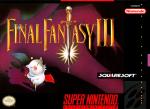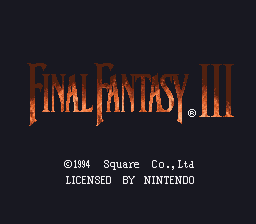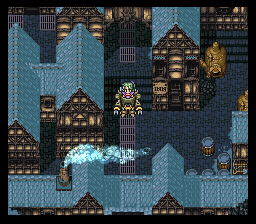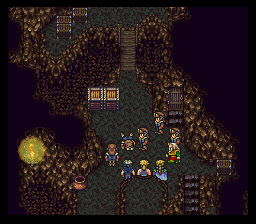Deep in the snowy mountains near the city of Narshe, a strange being called an Esper has just been discovered frozen in ice. Two soldiers of the lately hostile Gestahlian Empire are sent to investigate the matter, while also accompanying a young woman who seems to be under their control. Upon finding the strange creature, it uses magic to kill the soldiers and free the woman, making her realize she was being mind controlled the whole time as a test subject for the Empire's new technology, though her memory is fuzzy and she has trouble remembering anything else other than her name, Terra. Around her a group of unconventional people begins to form: freedom fighters, monarchs, warriors, magic users and even eccentric strangers are drawn together for different reasons, as the Emperor's right hand man Kefka begins to make his move and the world reveals the secret of magic to this curious band...
Final Fantasy VI was released in the USA as Final Fantasy III, causing quite a bit of confusion because of its unconventional numbering: the previous entry to be released stateside was Final Fantasy IV, renamed Final Fantasy II. (The matter is headache-inducing. Thankfully the next game of the series, Final Fantasy VII, did not have its title changed. For the purposes of this review, we will refer to game in its original title from now on.) From a game history standpoint, it is an important title: it is the last game of the franchise to be released for the SNES before its jump to the PlayStation, it marks the directorial debut of Yoshinori Kitase and Hiroyuki Itou, two people who would shape the series in a completely different direction from the last games, and it is the first game to explore science fiction elements, in contrast with the medieval fantasies of previous games. But the most important part of its legacy is its fame as one of the best RPGs of all time, if not the genre’s outright masterpiece. This is certainly a bold statement, and having to compete with such titles as Chrono Trigger, the Fallout series and the Pokemon games is by no means an easy feat. Is this 23-year-old game up to the task?
Judging solely by the visuals, one would recommend the game without a second thought. Simply put, it looks gorgeous for its time, and even nowadays. The series had long surpassed its humble 8-bit origins and employed far more sophisticated visual tricks, but the sheer amount of detail found in the backgrounds, the buildings and the machinery in the game is astounding. Movement had never been this fluid, and the color pallet, though not as bright and eye-catching as that of the previous games, is just as pleasing and sophisticated, going mostly for natural colors for the backgrounds and poppy, eye-catching tones for the clothing of the characters. Another important departure was the 3D design of the world map, which made the local topography grow bigger or smaller in comparison to where the player was in relation to it as they wander around. It also offers ample opportunity for sheer spectacle: the opening cinematic, with the soldiers guiding Terra through a blizzard to the city of Narshe, is one of the most awe-inspiring openings for a video game ever made. But probably the most memorable part about the game’s visuals is its character sprites. Not only are they bigger than average, allowing for more complex models and a wider range of body language, but they are also really expressive. They act like an actual human being would, but at the same time function like cartoon characters: they burst into laughter, they stoop their heads in disappointment, they sing, they dance, they move around like crazy, they get excited, scared, tired, and you can see this range of emotion reflected on them without a single doubt. Some of the most heart-breaking moments of the story don’t really need dialogue to work, as the visuals do all the work: a group hug to encourage a sad comrade, a dog moving around a grave and barking, two people sitting in the same room, reminiscing of past events but not brave enough to look at each other’s eyes…
All this talk about character moments gives this reviewer an ideal pass for the next high point of the game: its wonderful cast. According to interviews with Yoshinori Kitase, he and his fellow crew wanted to create an expansive cast of characters so that there wouldn't’t be a single protagonist and everyone on the team contributed material and ideas for them, and the story certainly reflects that. From the fourteen playable characters (the biggest roster in any Final Fantasy game before or since), twelve have a separate dramatic arc on their own, alongside the main story line. The story might begin with Terra’s search for purpose, but quickly expands and branches out to many subplots, but without feeling convoluted or overloaded, thanks to the game’s excellent pacing. Add to this an extremely memorable villain in the face of Kefka Palazzo, a psychopath that you can’t help but be both terrified and amazed by and who has even been compared to the Batman franchise’s Joker, and one can tell why the initial response to the game’s story was so positive all over the world. What really helps is that all the separate arcs are united under one theme: how can one pick up their pieces and find the courage to keep moving forward, after everything has gone wrong? The vast majority of the character’s back stories shares this component, be it a lost loved one, a destroyed kingdom, parental abandonment, regret over an incident from long ago or the search for redemption, and so does the main story, using a surprising twist somewhere at the middle of the main campaign. Thankfully, things are never too depressing, thanks the clever writing (even the not-that-up-to-par English translation manages to communicate it) and a wacky sense of humor that manages to make the game feel both like a true epic drama and a simple fairy tale, striking a very delicate balance. Many times the player will find themselves trying to hold back tears while at the same time having a wide, silly grin on their faces.
But when things do indeed get dramatic, the dialogue makes sure not to get too soapy and instead leaves the atmosphere and the music to handle it. And what a fine soundtrack that is. Nobuo Uematsu was no newbie when the time came to compose the music for the game, as this was his sixth collaboration with the producers of the franchise and he had already built a reputation as a skilled professional and a specialist of video game music. But it was this collection of themes that made his name well-known and recognized and finally put him in the hall of fame of great video game composers. All of the themes in the game are instantly recognizable, catchy and addictive, but it is a sense of unity that really brings the whole package together. The clever use of leitmotifs, simple music phrases that have a specific connection to each character, greatly helps in that regard. Not to mention the more ambitious moments of the score, like the mini-opera that the heroes attend at some point in the story. Uematsu is only limited by the SNES’s memory cartridge to include voice acting in the songs such as Aria di Mezzo Carattere (an instant fan-favorite), but even the cheeky use of sound effects can’t distract from what are some of the finest pieces of music in a video game. It can aid any atmosphere, be playful as it is creepy (Devil Lab, Zozo), triumphant (Edgar and Sabin) or anxious (Under Martial Law), be inspired by foreign music traditions (The Veldt), or even awe-inspiring and epic (the sixteen-minute-long Dancing Mad, the final boss theme, might be the crowning jewel of the collection and one of the finest boss themes ever. The fact that this song was written by the same person who penned the Carmina Burana-inspired One Winged Angel makes it even more amazing). Fans of the composer’s music should absolutely seek the album “Final Fantasy VI: Grand Finale”, to listen to the tracks performed by the Milan Symphony Orchestra, giving the music the scope and grandeur it always deserved.
The game at first does not appear to be that groundbreaking when it comes to its mechanics, as it follows on what the previous games of the series established, but not only did it introduce influential points, but also allowed for both amateur and seasoned players to enjoy, presenting them in an appealing way. The characters might not be clearly divided in Classes, as was the case with Final Fantasy IV, but, like the aforementioned game, each has unique commands to employ in battle: the Monk-like character Sabin has very high Attack stats and can use powerful moves to defeat his opponents, while Magic-user Celes can bounce back any magic attack that hits her and has exceptional Magic stats. The party size is reduced to four instead of five from the previous games, the Active Time Battle system is still used with a few tweaks and improvements (mainly to help the battle move more quickly and efficiently) and the (dreaded by quite a few gamers) random encounters are in full swing.
It is thanks to the addition of the Magicites that the game play is really elevated. Magicite is what is left behind after an Esper, a powerful magical being, passes away. It can be used to either teach magic spells to even characters who would otherwise never even touch a spell book and influence their stat growth, or summon the Esper who produced the stone to perform a task (a powerful magic attack, healing, boost stats, change the status of the party to a more favorable one) once a battle. In a way, they function similarly to the Job-teaching crystals in the previous game. This can be used to terrific effect and can be subject to the wildest experimentation imaginable: one can think of various combos to strengthen a particular player, make sure everyone on their team can heal, or create a party of immensely powerful wizards. The feature has proved to be rather divisive, as the more experienced players complain that it has made the game too easy, but the mechanic has a lot of staying power, as it has been used in a few games after the sixth (both Final Fantasy XI and XII use them) and has influenced other mechanics (the Materia System in Final Fantasy VII is certainly a different version of it).
This does not mean that the more experienced gamers can’t enjoy the game. The addition of more idiosyncratic characters, such the feral boy Gau who learns attacks can changes his stats by copying monsters, the dance-performing Mog, Umaro the Berserker, the wizard Strago who learns magic spells after watching his enemies, the mysterious figure Gogo who mimics whatever the other characters are doing makes the game play more interesting. An expanded bestiary, the ability to swap party members almost whenever the player wishes to in the story, a whole bunch of optional bosses and the Limit Break system from the next game in its infancy (in this case, it is an extremely powerful attack, initiated if the character has low HP, named “Desperation Attack” informally) add more flavor to an already intriguing package.
By reading this far into this review, one could suppose it would be an understatement to say that my feelings for Final Fantasy VI are fond. This might as well be my favorite RPG of all time. It functions terrifically well as a story, offers a lot of memorable set pieces and character moments, boasts a lovely score, has mechanics that are both easy to understand but really make you put more thought into them, it looks great. But is it really better than so many other classic titles? To be honest, I don’t really care about the answer, nor do I want to think about it. Video games have evolved beyond anyone’s craziest dreams in just a few decades, to the point that even detailed lists that surpass the two digits can’t do justice to entire genres. It is best to enjoy the vast variety of stories, modes and experiences we can access, instead of ranking the games so thoroughly. And maybe this is why I adore this game so much: it was the first that really showed me that games can go from cute pastime to treasured memory. And for that, I shall be forever grateful to it. |
 SuperCrash64 is Offline
| ID: 938511 | 44 Words
SuperCrash64 is Offline
| ID: 938511 | 44 Words
 SuperCrash64 is Offline
SuperCrash64 is Offline


 User Notice
User Notice 









 . Helped team trusted pull 300 points in the summer 2016 tdv competition.
. Helped team trusted pull 300 points in the summer 2016 tdv competition.